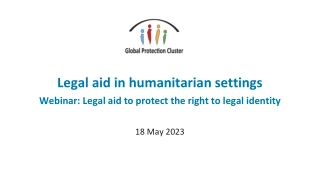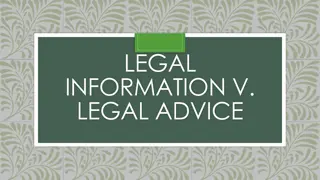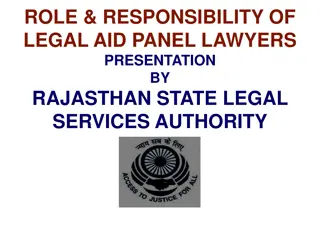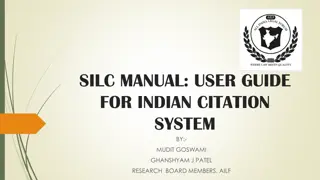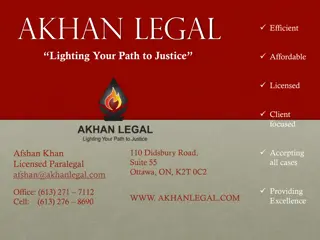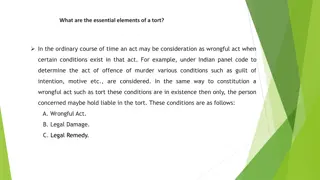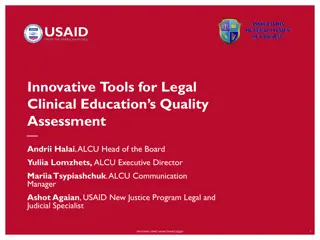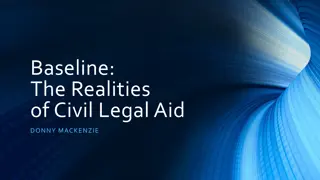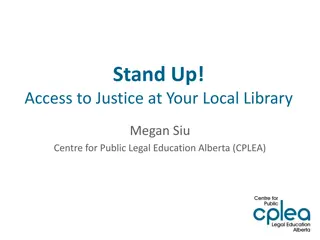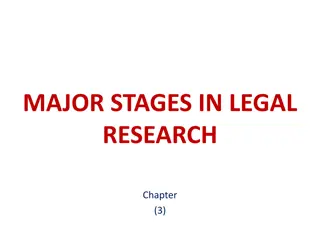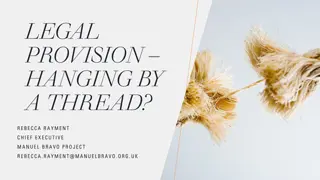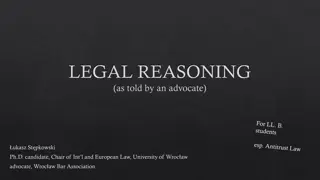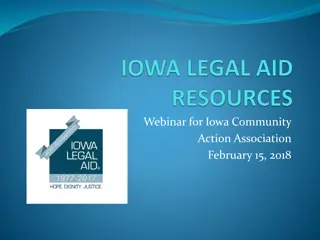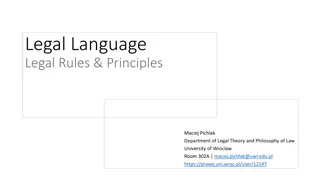Mastering Legal Research Techniques
Delve into the intricacies of legal research techniques by learning how to read, cite, extract principles from cases, and construct case notes efficiently. Discover tips to enhance your understanding and streamline your research process.
Download Presentation

Please find below an Image/Link to download the presentation.
The content on the website is provided AS IS for your information and personal use only. It may not be sold, licensed, or shared on other websites without obtaining consent from the author.If you encounter any issues during the download, it is possible that the publisher has removed the file from their server.
You are allowed to download the files provided on this website for personal or commercial use, subject to the condition that they are used lawfully. All files are the property of their respective owners.
The content on the website is provided AS IS for your information and personal use only. It may not be sold, licensed, or shared on other websites without obtaining consent from the author.
E N D
Presentation Transcript
Module 2: The Basics of Legal Research LAW1231: Lectures 11-12 Let s Get Technical
Introduction Introduction Now that we have the big picture, it is time to fill in some of the smaller details: such as how to read cases and how to refer to them.
Learning Objectives Learning Objectives By the end of the Module, you will be able to: 1. Describe the nature and technique of legal reading 2. Research legal information 3. Apply legal citation forms and legal formats 4. Extract principles from cases 5. Construct notes about cases to assist in recalling them
Extracting Principles from Cases How to Read Cases Some students have asked me whether there are any hints for reading and remembering cases. It is a good question because your worksheets will often have long lists of cases - some of which appear randomly on exams. The good news is that while reading cases is very painful at first, it becomes much easier as you get better at it especially when you work out which parts you can skim.
Extracting Principles from Cases How to Read Cases Cont d Tip: On one website, Law School Hacker, the author quoted Scott Turow who said that reading legal opinions was like stirring cement with your eyelashes ! Hacker then went on to note that writing case briefs was a lot like wax-on/wax-off from Karate Kid. It might seem puzzling at first, but it all comes together in the end and you move on to other skills. In addition, as you practice, you start going a lot faster.
Extracting Principles from Cases Tip: What Can you do to Make Life a Little easier? 1. Google is your friend see if there are any descriptions of the case online. For famous cases such as Donoghue v Stevenson, there are lots of case summaries and discussions. 2. Read the case headnotes these are short explanations in the case reports 3. Get together a group of friends and assign cases. This works well for courses where you have 20-30 cases on your worksheet. However, there will always be some cases that you just have to read for yourself. Especially since all of these sources might be somewhat inaccurate or misleading. If you are not understanding the notes you find, and the case is an important one, go and find it for yourself.
Extracting Principles from Cases How to Read Cases: Where to Start It is often useful to page through the case first looking at the subheadings or reading a few words from random paragraphs. This gives you a feel for how long the case is and how many issues there are. If there are multiple judges, then you can also try to figure out which are in the majority and which are dissenting. Now start reading slowly. Skip over paragraphs that do not initially make sense. Try to get a feel for where the case is going. Sometimes judges give the background facts as a narrative. Other times, they describe the evidence of the parties and say whether they believe the parties or not. You can usually skim through this part on this reading.
Extracting Principles from Cases Making Sense of the Case: Your goal is to make a big picture out of these puzzle pieces. 1. What is the case about? 2. Who are the parties? 3. Why did they come to court? 4. Is there a clear legal doctrine that covers the situation? 5. If you had to tell your neighbour about the case, how would you describe it? 6. What if you had to come up with a one-line headline about the case for the newspaper? Tip: Note that the case will often be full of legal jargon. This is because the judge is writing for other judges and lawyers, not for ordinary people. Sometimes there will be Latin involved. If you cannot understand the case because of the jargon, then take time to research the jargon.
The Details For now, let us review the very basics: What is a case?
The Details What is a case? What we study as cases are decisions given by judges. Most cases arise because two or more persons are in conflict. These persons are called the parties . When the parties are both private, the case is called a civil case or suit. Who are the parties in a Case ? The person who starts the case is called the Claimant , Plaintiff or Applicant . The plaintiff can be an individual or an artificial person such as a company or association. In civil matters, the claimant sues the Defendant who is sometimes called the Respondent .
The Details Who are the parties in a criminal case? In criminal cases, the person prosecuting the case is almost always the State/Crown. The accused person is called the defendant. It is common to see these cases named as R v Hall where R stands for Regina (The Queen) or The State v Hall Note that the v is usually read as and , against or v . It is not common in our jurisdictions to say versus . In criminal cases, you will sometimes see DPP (Director of Public Prosecutions), COP (Commissioner of Police) and AG (Attorney General) as case parties in their official capacities.
The Details How Does a Civil Case get to Court? In civil cases, the claimant prepares a Claim in a special format called a Claim Form . This might also be called a Writ , Summons , Application , Petition or Prayer for Relief . There are a few other words in other jurisdictions. There can be more than one claimant. The claimant starts the suit by filing the claim at the Court Registry. This means handing in the document to the Registry which stores all of the documents relating to the Court. The Registry staff create a file for the case, set dates for hearing and ensure that the judge gets a copy of all of the documents on the file. The claimant delivers (serves) the claim to the defendant who files a defence. There can be more than one defendant.
The Details The defendant can also file a counter-claim seeking a remedy against the claimant. For example, following a motor vehicle collision where both parties blame each other, the claimant might sue the defendant for loss and damages, and the defendant might counter-claim.
The Details How does a criminal case get to court? The police arrest the defendant and lay a complaint against him/her. This contains one or more charges: Lesser charges (sometimes called misdemeanours or summary offences) may be heard in the Magistrate s Court. This is called a summary trial. More serious charges (called indictable offences) must be heard by the High Court.
The Details Reasons for A Civil Law Suit The reason for the suit is called the cause of action . Causes include defamation, negligence, breach of contract, trespass, wrongful dismissal, etc. Naming Cases The names of the cases are generally the names of the parties, e.g. A v B. These might be anonymized.
The Details Cases Without Conflict Note that there are some cases where there is no conflict. For example, a person might apply to the Court for a paternity order, stating that Mr. X is their father. These cases carry names such as Re Hallett s Estate and In the Matter of the Paternity of X. The Attorney General can refer questions to the Court of Appeal so that they can give guidance. You will come across some of these cases from the UK such as AG s Reference No. 3 of 2012.
The Details Written Evidence Giving Evidence in a Case In all cases, the parties give Evidence their version of events. Evidence can be given in written form as statements , affidavits or oaths . It can also be in oral form. The person giving the evidence is called the witness or deponent. This person takes the witness stand and swears (or affirms) to tell the truth. They give their evidence-in-chief guided by their lawyer (or the prosecutor). The other side will then cross-examine them asking a series of questions trying to discredit the evidence. This Photo by Unknown Author is licensed under CC BY-SA After the evidence, the lawyers make submissions to the court, either orally or in writing.
The Details Decisions in Cases The judge then gives a decision. In some criminal and civil cases, the jury makes decisions about the facts. These are called the findings of fact. For example, was the hat blue or red? Did Jack fall or was he pushed? The jury listens to the witnesses and says which version of events it believes. In other cases, the judge is the arbiter of fact . In all cases, the judge is the arbiter of law . A party who is not happy with the judge s decision can appeal to the court above in the hierarchy.
The Details Decisions in Cases The appeal court will review the judge s decision and allow the appeal (say that the judge below was wrong) or deny the appeal (say that the judge below was right). In some cases, a party needs leave (permission) to appeal. The court might decide not to give leave if there is very little possibility of success.
The Details Decisions in Cases If there is more than one judge, each judge might give a decision. Judges might reach the same decision for different reasons (on different grounds). The majority rules. Judges who have a different conclusion are called dissenting judges. The statements of the judges are called dicta. The ratio decidendi is the principle of law that the judge used in reaching a decision. When a judge makes a statement that is not directly related to the final decision, this is said to be obiter dicta.
Using Cases in your Answers Tip: A Brief Mention How to Cite Cases in Essays When you are answering essay or problem questions, you often find yourself referring to cases. What are the important parts of the case that you need to put down? It depends on what you are using the case for. If you just want to cite a quick principle, then you state the principle and write the case name. For example: On the one hand, manufacturers have a duty of care towards their customers: Donoghue v Stevenson [1932] AC 562. On the other hand ...
Using Cases in Your Answers Tip: A Brief Mention How to Cite Cases in Essays Here is an example from the decision in Antoniades v Villiers [1988] UKHL 8, [1988] 3 WLR 139: (1) The court should be astute to detect and frustrate sham devices and artificial transactions whose only object is to disguise the grant of a tenancy and to evade the Rent Acts (Street v Mountford at p 825H). The court has to be especially wary and especially careful to see that things like premiums are not being used to conceal payments of rent and so on (Aldrington Garages v Fielder (1978) 37 P & CR 461* at p 499 per Geoffrey Lane LJ as he then was).
Using Cases in your Answers A Longer Mention How to Cite Cases in Essays Other times, you will need to expand a little bit on the legal principle. For example: In the case Katrina Smith v Albert Anthony Selby [2017] CCJ 13 (AJ) the Court considered the social aims of Parliament in creating the legislation and gave a broad interpretation ... Here is an example from Street v Mountford Occupation by service occupier may be eliminated. A service occupier is a servant who occupies his master's premises in order to perform his duties as a servant. In those circumstances the possession and occupation of the servant is treated as the possession and occupation of the master and the relationship of landlord and tenant is not created; see Mayhew v. Suttle (1854) 4 El. & Bl. 347.
Using Cases in your Answers A Longer Mention How to Cite Cases in Essays Notice that we did not discuss the facts of the case in the examples above. There are times, however, that the facts of the case are very relevant. Sometimes you will give a brief summary as a point of interest or to show how the principles apply to those facts. For example: Tuberville v Savage (1669) 86 ER 684 is an example of a case where the court found that there was no assault. The Plaintiff and Defendant had a quarrel. The Plaintiff put his hand on his sword and said, If it were not assize time, I would not take such language from you. The court held that the Defendant had no reason to expect imminent bodily harm.
Using Cases in your Answers A Longer Mention - How to Cite Cases in Essays Here is another example from Street v Mountford The cases on which Mr. Goodhart relies begin with Booker v. Palmer [1942] 2 All E.R. 674. The owner of a cottage agreed to allow a friend to install an evacuee in the cottage rent free for the duration of the war. The Court of Appeal held that there was no intention on the part of the owner to enter into legal relationships with the evacuee.
Using Cases in your Answers Extensive Discussion - How to Cite Cases in Essays Finally, there are times when you will go into the facts extensively. This will happen especially when you are doing a problem question with similar facts. You will want to explain the case in sufficient detail that the reader can understand why certain characteristics or tests are important. You will then compare your fact pattern and show where the variations are and why they are significant.
Using Cases in your Answers Example of an Extensive Discussion From Street v Mountford again: In Isaac v. Hotel de Paris Ltd. [1960] 1 WLR 239 an employee who managed a night bar in a hotel for his employer company which held a lease of the hotel negotiated "subject to contract" to complete the purchase of shares in the company and to be allowed to run the nightclub for his own benefit if he paid the head rent payable by the company for the hotel. In the expectation that the negotiations "subject to contract" would ripen into a binding agreement, the employee was allowed to run the nightclub and he paid the company's rent. When negotiations broke down the employee claimed unsuccessfully to be a tenant of the hotel company. The circumstances in which the employee was allowed to occupy the premises showed that the hotel company never intended to accept him as a tenant and that he was fully aware of that fact. This was a case, consistent with the authorities cited by Lord Denning in giving the advice of the Judicial Committee of the Privy Council, in which the parties did not intend to enter into contractual relationships unless and until the negotiations "subject to contract" were replaced by a binding contract.
Using Cases in your Answers Direct Quotations You can see that even the detailed descriptions of the facts do not get too long. Sometimes the judges will quote relevant statements from previous cases. Note that this is hard to do in your exams. For example (Street v Mountford): A contrary conclusion was reached in Taylor v. Caldwell (1863) 3 B. & S. 826 in which the defendant agreed to let the plaintiff have the use of the Surrey Gardens and Music Hall on four specified days giving a series of four concerts and day and night fetes at the gardens and hall on those days, and the plaintiff agreed to take the gardens and the hall and to pay 100 for each day. Blackburn J said at p. 832: "The parties inaccurately call this a 'letting,' and the money to be paid a 'rent,' but the whole agreement is such as to show that the defendants were to retain the possession of the hall and gardens so that there was to be no demise of them, and that the contract was merely to give the plaintiffs the use of them on those days."
Learning Activity Rewrite the following extract as a one-liner Tuberville v Savage (1669) 86 ER 684 is an example of a case where the court found that there was no assault. The Plaintiff and Defendant had a quarrel. The Plaintiff put his hand on his sword and said, If it were not assize time, I would not take such language from you. The court held that the Defendant had no reason to expect imminent bodily harm.
Learning Activity Rewrite the following extract as a one-liner In Woollin [1999] AC 82, D threw his 3-month-old baby against a hard surface but said that he did not intend to kill him. The court held that the correct direction to the jury was as follows: Where the charge is murder and in the rare cases where the simple direction [intent to kill or cause GBH] is not enough, the jury should be directed that they are not entitled to find the necessary intention, unless they feel sure that death or serious bodily harm was a virtual certainty (barring some unforeseen intervention) as a result of the defendant s actions and that the defendant appreciated that such was the case.
Learning Activity Rewrite the following extract as a one-liner: In McEwan [2018] CCJ 30 (AJ), the four appellants are trans women who were arrested and convicted in 2009 of the cross-dressing offence found at section 153(1)(xvlvii) of the Summary Jurisdiction (Offences) Act of Guyana, which is an 1893 law. The four spent three nights detained at a police station after their arrest for the minor crime. At their trial, the magistrate told them that they were confused about their sexuality, that they were men and not women, and urged them to go to church. In 2010, the four appellants brought an action challenging the constitutionality of the offence and the statements made by the magistrate.
Learning Activity The CCJ looked at the historical context of this post-slavery vagrancy law and concluded that it was a law from a different time that no longer served a legitimate purpose in Guyana. The panel of CCJ judges comprised the President, the Hon. Mr. Jacob Wit, the Hon Mr. Justice Winston Anderson, the Hon. Mme. Justice Maureen Rajnauth-Lee and the Hon. Mr. Justice Denys Barrow. The entire panel of five judges concluded that the law was unconstitutionally vague. The Court said that laws must define criminal offences with sufficient clarity that ordinary people can understand what conduct is prohibited. The majority concluded that the vagueness left transgender persons in great uncertainty as to what is and is not allowed and also gave law enforcement virtually unlimited discretion in applying the law. Source: U-RAP (University of the West Indies Rights Advocacy Project), accessed via http://www.u-rap.org/web2/index.php/component/k2/item/77-joint-press-release-on-mcewan-v-ag-of-guyana-nov-13-2018 on Sep 18, 2019
Reading Cases In reading cases, you will usually find that the judge will start by going through the facts. The judge should then discuss the law that applies in the case. Sometimes this is done by referring to the arguments that the parties have made. Finally, the judge comes to a conclusion and makes orders. Note that this is the FILA/IRAC structure that we spoke of.
Reading Cases Understanding Case Citations The citation is the name of the case and the report in which it appears. After the first time, you can use a shortened form. Note that the citation includes the year and the name of the report along with the page number. If the report is indexed by year, then you use square brackets. If it is indexed by volume, then put the year in round brackets. The case name itself is italicized or underlined. e.g., Donoghue v Stevenson [1932] AC 562 Donoghue Charles, Carter and Carter v The State (1999) 54 WIR 455 Sometimes courts have their own citations, e.g. Katrina Smith v Albert Anthony Selby [2017] CCJ 13 (AJ). Selby If a case does not appear in a law report, it is said to be unreported. Instead make a note of the court s case number and the date it was decided. E.g. Selby v Smith (unreported) Barbados HC 629/2008 decided August 6, 2010.
Useful Resources Useful Resource Links (Not Mandatory) OSCOLA: Oxford University Standard for the Citation of Legal Authorities (4th ed, Faculty of Law, University of Oxford, 2012). Available via https://www.law.ox.ac.uk/sites/files/oxlaw/oscola_4th_edn_hart_2012.pdf OSCOLA 2006 Citing International Law Sources (Faculty of Law, University of Oxford, 2006). Available via https://www.law.ox.ac.uk/sites/files/oxlaw/oscola_2006_citing_international _law.pdf - This is for the international law OSCOLA Quick Reference Guide Faculty of Law, University of Oxford (n.d.). https://www.law.ox.ac.uk/sites/files/oxlaw/oscola_4th_edn_hart_2012quick referenceguide.pdf - This is the quick reference guide.
Making Notes In making your notes, cite the case properly, give the facts briefly, and then give the final outcome. Decide how much you want to write about the legal principles involved. Sometimes you will be familiar with the legal principle and the case will just show a new twist. Other times, you will have to write quite extensively on why the judges ruled as they did. Make sure you understand any metaphors, especially if your course director has highlighted them.
Making Notes Think of the case like a book report. You have to read the book and answer the following questions for your report: 1. Facts: name of the case and its parties, what happened factually and procedurally, and the judgment 2. Issues (what is in dispute) 3. Holding (the applied rule of law) 4. Rationale (reasons for the holding).... 5. Dicta (commentary about the decision that was not the basis for the decision) 6. Dissent (if a valuable dissenting opinion exists, the dissent s opinion) 7. Party s Arguments (each party s opposing argument concerning the ultimate issue) 8. Comments (personal commentary).
Making Notes Alternatively, you could give the short version: 1. Facts 2. Issues 3. Principle of law 4. Outcome
Making Notes People use different strategies from highlighters to index cards. Find what works for you. Unfortunately, the LLB programme is memory intensive. You will cram a lot of cases into your brain to prepare for your exams, and then you will promptly forget them by the following semester. I found it helped to write practice essays explaining the law in the area. Once the cases were fit into this narrative, then they became easier to remember. I would review the essays just before the exam. Another benefit of doing this is that writing the essays in the exam also became a lot easier since I already had structures in my mind.
Making Notes There are different ways to make the case more accessible for yourself, for example: 1. Highlighting 2. Making paragraph sub-headings 3. Making a mind map 4. Making flash cards Here are some examples of how to tackle the Street v Mountford case (see the next 2 slides).
Highlighting Here we use different colour highlights for different purposes: Red - ratio or legal reasoning Blue - material facts Green - obiter dicta Orange - statements of social significance Yellow - issue in the case Purple - the decision
Adding Subheadings Another option is to mark up the paragraphs, giving subheadings. By doing this, you are reading more carefully and also placing markers. Make a summary by putting together all your paragraph headings.
Mind Mapping If you are a visual thinker, you can create a mind map. The idea is to start with a topic in the centre, and then make connections to other themes. (I am no-way, no-how a visual thinker if you are, don t let my feeble attempt scare you away!) Many persons find it helpful to colour code this as well (see the next slide).
Flashcards Flashcards are especially useful when you have to do strict memorization. I think that the best law exams will require students to analyze rather than memorize, but there will be times when you just need to stuff your head with data. Reviewing information multiple times will strengthen your memory recall as well. Flashcards can be done on actual cards, or online
Example Notes Let us write our book report for Street v Mountford: 1. Facts: name of the case and its parties, what happened factually and procedurally, and the judgment Landlord (Street) attempted to bypass the Rent Acts by making his tenant (Mountford) sign a Licence Agreement . The Court at first instance held that this was a lease. The Court of Appeal said that the freedom to contract was important and held that it was a licence. The House of Lords, examining the agreement for sham conditions, said that it was a lease as M had exclusive possession. 2. Issues (what is in dispute) Whether the Agreement was a licence or a lease 3. Holding (the applied rule of law) if there is a written agreement between an owner and occupier which confers exclusive possession at a rent for a term, the parties cannot chose to call this a licence if it is otherwise a tenancy Exclusive possession at rent for a term is a lease
Example Notes 4. Rationale (reasons for the holding) A lease can be defined as the grant of exclusive possession for a term at a rent (although rent is not strictly required) A court is entitled to look behind the label given to an agreement to decide whether in fact a lease was granted, but disguised as a licence The agreement here was clearly a lease, therefore Mountford was entitled to legislative protection under landlord and tenant legislation This case put an end to sham licences, reversing cases such as Somma v Hazlehurst [1978] 5. Dicta (commentary about the decision that was not the basis for the decision) Discussion of previous cases and whether court agreed with decisions Examples of what would not be a lease eg. Service tenancy. 6. Dissent (if a valuable dissenting opinion exists, the dissent s opinion) 7. Party s Arguments (each party s opposing argument concerning the ultimate issue) None, unless to be found in CA s judgment. 8. Comments (personal commentary). See also Hazelhurst v Somma


